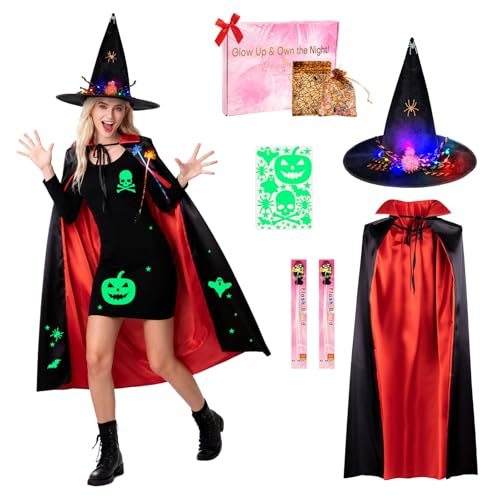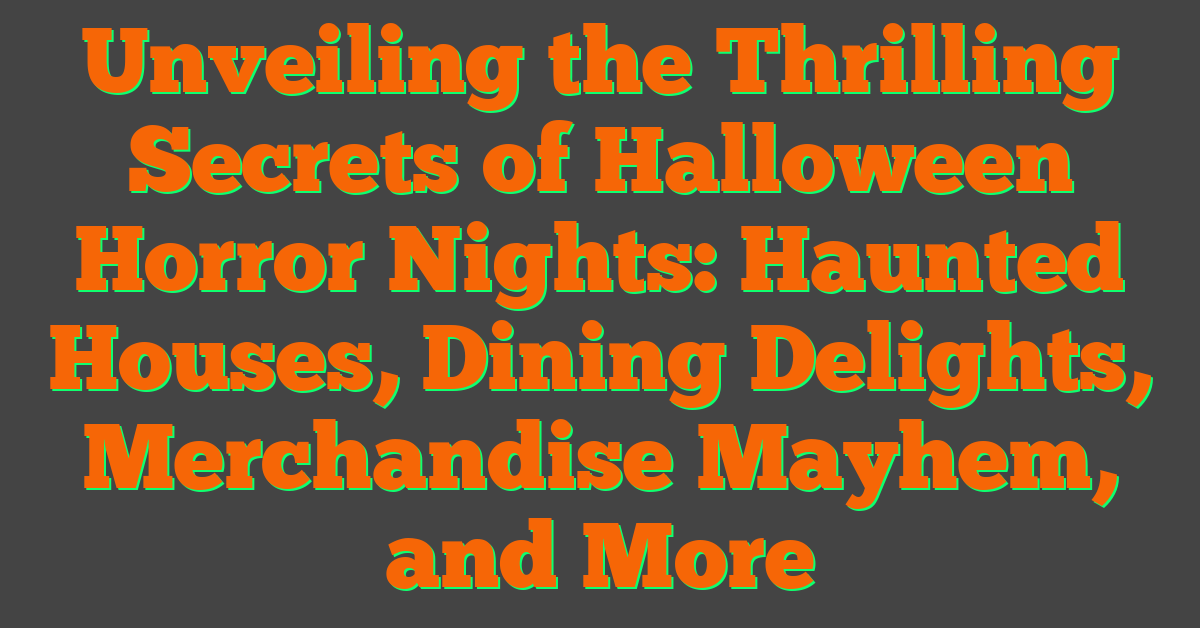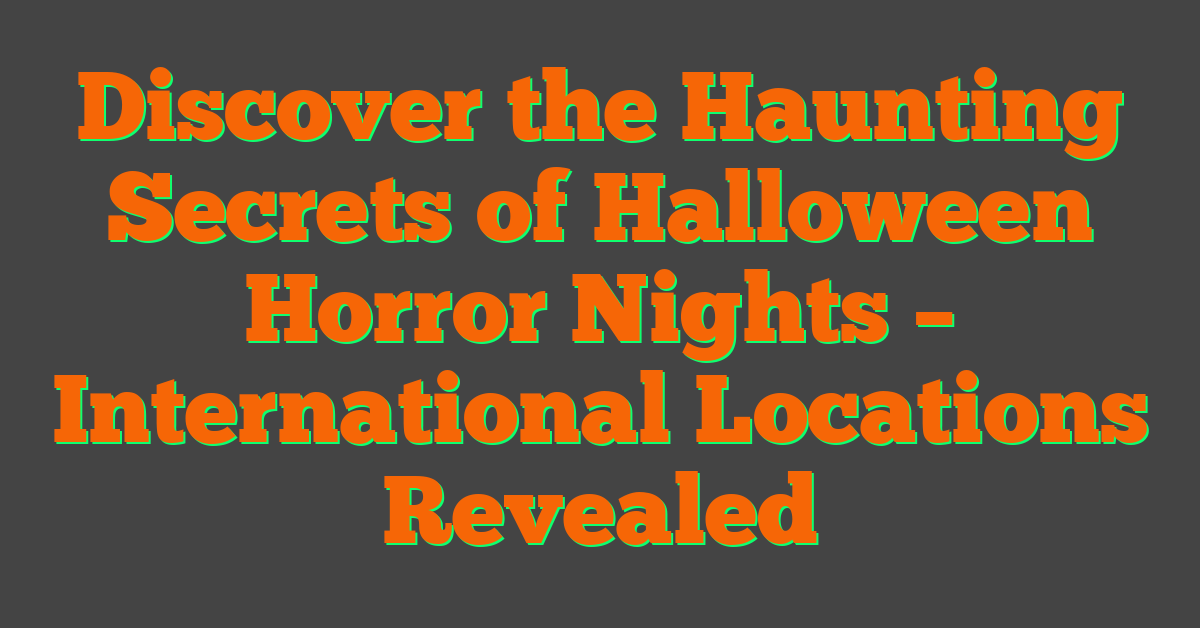Halloween, a widely celebrated holiday, originated from ancient Celtic traditions and has evolved over time. While it is most prominent in the United States, Halloween is also observed in various other countries across the globe.
To understand the significance of Halloween outside the US, it is essential to explore its origins and the traditions associated with it. Halloween is believed to have originated from the ancient Celtic festival of Samhain, which marked the end of the harvest season and the beginning of winter. It was believed that on this day, the boundary between the living and the dead was blurred, and people lit bonfires and wore costumes to ward off ghosts.
In the United States, Halloween is celebrated with great enthusiasm, featuring traditions such as trick-or-treating, costume parties, haunted houses, and the carving of Jack-o’-lanterns. These activities have become deeply ingrained in American culture.
Halloween celebrations differ in other countries, influenced by their unique cultural and historical backgrounds. Some countries, like Canada, Ireland, and the United Kingdom, have similar Halloween traditions due to their shared Celtic heritage. Other countries, like Mexico, celebrate the Day of the Dead, a holiday honoring deceased loved ones. In Japan, Halloween has gained popularity in recent years as a commercial event centered around costumes and decorations. Cultural differences influence the specific customs and rituals associated with Halloween in each country.
By delving into the origins, traditions, and celebrations of Halloween both in the United States and outside of it, we can gain a comprehensive understanding of how this festive occasion is embraced and celebrated worldwide.
Key takeaway:
- Halloween originates from ancient Celtic festivals and has evolved into a cultural celebration with various traditions and beliefs associated with it.
- In the United States, Halloween is widely celebrated with activities such as costume parties, trick-or-treating, haunted houses, and pumpkin carving.
- While Halloween is not as widely celebrated outside the United States, it is gaining popularity in many countries with unique cultural differences in how it is celebrated.
The Origin of Halloween
Halloween, or All Hallows’ Eve, originated from the ancient Celtic festival of Samhain. The festival marked the end of the harvest season and the beginning of winter.
The Origin of Halloween Celts believed that on October 31st, the boundary between the living and the dead was blurred, allowing spirits to roam free.
To ward off these spirits, Celts lit bonfires and wore costumes to confuse and scare them away. They also believed that during Samhain, the Celtic priests, called Druids, had increased powers of divination and could communicate with the dead.
Over time, the Catholic Church incorporated some Samhain traditions into its own. November 1st became All Saints’ Day, and the night before became All Hallows’ Eve, eventually becoming Halloween.
Today, Halloween is widely celebrated worldwide, with varying traditions among different countries. It has become a holiday of costumes, trick-or-treating, haunted houses, and pumpkin carving. Halloween’s origins remind us of its Celtic roots and the connection between the living and the spirit world.
How Did Halloween Start?
Halloween, also known as All Hallows’ Eve, has its origins in the ancient Celtic festival known as Samhain. This festival, which marked the end of the harvest season and the beginning of winter, was believed to be a time when spirits freely roamed the Earth. To protect themselves from these spirits, people would light bonfires and wear costumes. Divination was practiced during this festival.
Over time, the Celtic traditions of Samhain merged with Christian customs. In the 8th century, Pope Gregory III proclaimed November 1st as All Saints’ Day, and the evening before became known as All Hallows’ Eve, or Halloween.
Halloween gained popularity in the United States during the early 20th century. Communities started hosting parties, parades, and the tradition of trick-or-treating. Today, Halloween is celebrated by both children and adults, with costume parties, festive decorations, and delicious treats. Symbols like pumpkins, black cats, and witches have become iconic representations of this holiday.
Now, let’s delve into a true Halloween story. A group of friends, curious and seeking adventure, decided to explore an abandoned house that was rumored to be haunted. As they walked through the dark corridors, they heard eerie noises and saw mysterious shadows. Instead of succumbing to fear, they laughed and embraced the excitement of the experience. In the end, they discovered that the house was not haunted after all. This thrilling adventure brought them closer together and created lasting memories, reminding them that sometimes the most memorable and enjoyable moments can be found in the face of fear.
What are the Traditions and Beliefs Associated with Halloween?
Halloween is linked to customs and beliefs that have changed over time. These traditions and beliefs are what make Halloween so unique and special.
One of the most well-known Halloween traditions is costume wearing. People of all ages, especially children, love dressing up as their favorite characters or spooky creatures. This tradition dates back to the ancient Celtic festival of Samhain, where costumes were worn to protect against evil spirits.
Trick-or-treating is another widely practiced Halloween tradition. Children go door-to-door in their neighborhoods, saying “trick or treat” and collecting candies or treats from their neighbors. This tradition originated from the medieval practice of “souling,” where people would go door-to-door offering prayers for the souls of the dead in exchange for food.
Jack-o’-lanterns, carved out of pumpkins, are also an integral part of Halloween. Originally, turnips or potatoes were used, but Irish immigrants in America discovered that pumpkins were more readily available. These lit pumpkins serve the purpose of warding off evil spirits and creating a spooky ambiance.
Haunted houses and ghost stories are another aspect of Halloween that brings excitement and chills. People enjoy being frightened and immerse themselves in the supernatural during this time. This tradition is closely tied to the belief that during Halloween, the line between the living and the spirit world is blurred, allowing spirits to freely roam.
These Halloween traditions and beliefs have evolved over time and have become an essential part of the holiday. They create a festive and spooky atmosphere that everyone can enjoy. So, what are the traditions and beliefs associated with Halloween? They are what make Halloween so fascinating and captivating.
Halloween Celebrations in the United States
Halloween Celebrations in the United States include costume parties, trick-or-treating, and spooky home decorations.
The holiday is on October 31st and is popular for both kids and adults.
Trick-or-treating involves kids going door-to-door in their neighborhoods, wearing costumes and asking for candy.
Adults often have costume parties with creative outfits.
Carving pumpkins into jack-o’-lanterns and displaying them outside is also common.
Haunted houses and corn mazes are popular attractions for those seeking a scare.
Halloween in the United States showcases the nation’s creativity and festive spirit for all ages.
How is Halloween Celebrated in the United States?
Halloween is celebrated in the United States with various traditions and activities that bring people together. Here are some of the main ways it is observed:
1. Trick-or-treating: Children dress up in costumes and go door-to-door in their neighborhoods, saying “trick or treat” to collect candy.
2. Halloween parties: People of all ages gather for festive parties, often in costume. These parties include games, dancing, and themed decorations.
3. Haunted houses: Many communities set up haunted houses or trails for people to walk through and experience scares and thrills.
4. Pumpkin carving: It is a common tradition to carve pumpkins into jack-o’-lanterns. People use lit candles inside them to create a spooky atmosphere.
5. Costume contests: Competitions are held in various locations to showcase creative and unique costumes. Some contests offer prizes for the best costumes.
6. Festive decorations: People decorate their homes and yards with skeletons, fake spider webs, and other spooky décor to create an eerie ambiance.
7. Horror movie marathons: Many enjoy watching scary movies throughout October, both at home and in movie theaters.
Pro-Tip: Remember to prioritize safety on Halloween by using reflective materials on costumes, carrying flashlights, and accompanying younger children while trick-or-treating.
Popular Halloween Symbols and Activities in the United States
The Popular Halloween Symbols and Activities in the United States are an essential part of Halloween celebrations. Here are some common ones:
– Pumpkin: Carving pumpkins into jack-o’-lanterns is a beloved tradition. People display these faces on their doorsteps and windows.
– Costumes: Dressing up is a major part of Halloween. Children and adults enjoy becoming their favorite characters, creatures, or objects.
– Trick-or-treating: Children go from house to house, dressed in costumes, saying “trick or treat” to receive candies and treats. It is a popular activity for families and communities.
– Haunted houses: Many towns and cities set up haunted houses where people can have thrilling scares and spooky adventures. These attractions are especially popular during Halloween.
– Apple bobbing: This game involves trying to catch floating apples using only your mouth. It is often played at Halloween parties.
– Halloween parties: From costume parties to themed gatherings, Halloween parties are a common way for people to celebrate. They often feature music, games, and decorations.
– Scary movies: Watching horror movies is a popular activity during Halloween. Many people enjoy getting into the spooky spirit by watching classic horror films or new releases.
These Popular Halloween Symbols and Activities in the United States contribute to the fun and excitement of Halloween, creating memorable experiences for people of all ages.
Halloween Celebrations Outside the United States
Halloween Celebrations Outside the United States have become increasingly popular in recent years. In many countries such as Canada, the United Kingdom, and Australia, Halloween is celebrated with similar customs to those in the US. People dress up, go trick-or-treating, and decorate their homes with spooky decorations. In Canada, Halloween is widely celebrated, with millions actively participating each year. The United Kingdom has also fully embraced Halloween, with over half the population now joining in the festivities. Australia has organized numerous trick-or-treating events and extravagant Halloween parties.
It is noteworthy that Halloween Celebrations Outside the United States may differ from those in the country. For instance, in Mexico, they celebrate the Day of the Dead, which coincides with Halloween but has its own unique traditions. In Japan, Halloween has gained popularity among young adults and frequently involves costume parties and club events.
Is Halloween Celebrated in Other Countries?
Halloween is celebrated in several countries around the world, not just the United States. Countries like Canada, Ireland, and the United Kingdom have similar origins and celebrate with costume parties, pumpkin carving, and trick-or-treating.
Mexico celebrates the Day of the Dead alongside Halloween, honoring deceased loved ones with colorful altars and gatherings at cemeteries.
How is Halloween Celebrated in Other Countries?
Halloween is celebrated in many countries, but customs vary. In some countries, like Mexico and Japan, it is a time to honor departed loved ones and also embrace the festivities with costumes, parades, and parties. Japan has also embraced Halloween with costumes, parades, and parties. In Ireland, where Halloween began, they have bonfire festivals and games like bobbing for apples. Each country has its own unique customs and celebrations. Despite the differences, dressing up, decorating homes, and community events are common themes in Halloween celebrations globally. So, How is Halloween Celebrated in Other Countries?
Cultural Differences in Halloween Celebrations
In Mexico, Dia de los Muertos (Day of the Dead) is celebrated at the same time as Halloween. Families create altars to honor their deceased loved ones and offer food, drinks, and marigolds as symbolic offerings.
In Japan, Halloween is a new celebration that has gained popularity in recent years. It is not traditionally associated with costumes and trick-or-treating. Instead, people celebrate with Halloween-themed events, parties, and decorations.
In Ireland, where Halloween originated, the holiday has deep cultural roots. People light bonfires, carve turnips (traditionally), and participate in traditional games like snap apple.
In China, Halloween is not widely celebrated. There is a similar festival called Qingming or Tomb Sweeping Day, where people visit the graves of their ancestors, clean the tombstones, and make offerings. To learn more about how Halloween is celebrated around the world, you can visit is halloween celebrated outside the us.
In Scotland, Halloween is called Samhain and is celebrated with traditional rituals such as guising, where children dress up in costumes and go door-to-door singing or telling jokes in exchange for treats.
In France, Halloween celebrations have become more popular in recent years, especially in big cities. I was living in Paris and decided to attend a Halloween party. The effort people put into their costumes and the festive atmosphere amazed me. There was a cultural difference with trick-or-treating. In France, children do not commonly go door-to-door asking for candies. Instead, people organize parties or visit themed events to celebrate Halloween. It was a fun experience that showed how cultural differences can shape holiday celebrations.
Frequently Asked Questions
1. How is Halloween celebrated outside of the United States?
Halloween is celebrated differently around the world. In Mexico, it is followed by el Día de los Muertos, where families honor their deceased loved ones by preparing feasts, leaving gifts on gravesites, and wearing skull masks. In England, Halloween is overshadowed by Guy Fawkes Day on Nov. 5, where bonfires are lit to commemorate the failed assassination of King James I. In Italy, Nov. 1 is dedicated to Ognissanti, or “all saints,” and celebrations vary by region, including rising from the dead in Sicily and going door to door for offerings in Sardinia. In Guatemala, the Barriletes Gigantes festival involves flying massive kites to honor the dead as a bridge between the living and the deceased. In Japan, Halloween is a new holiday focused on costumes and parties, with trick-or-treating not as popular due to other holidays for the deceased. Ireland is where Halloween originated, and festivals like Púca and Derry Halloween celebrate the Celtic holiday. In China, the Qingming festival in April is dedicated to honoring the deceased by cleaning and sweeping their tombs.
2. How is Halloween celebrated in the United Kingdom?
In the UK, Halloween is celebrated alongside the Gaelic festival of Samhain. This ancient festival marked the end of the harvest season and the beginning of winter. British children often participate in “trick-or-treating” by going from house to house, asking for candy. Another important holiday in the UK is Guy Fawkes Day, which falls on November 5th. Bonfires are lit to commemorate the failed assassination attempt on King James I by Guy Fawkes and his group. It is traditional to create an “effigy” of Guy Fawkes, called a “Guy,” and ask for a “penny for the Guy” as a form of donation.
3. How is Halloween celebrated in Mexico?
In Mexico, Halloween is celebrated along with el Día de los Muertos (the Day of the Dead), which is a two-day celebration to honor departed loved ones. Families create altars to the dead and decorate them with marigold flowers, candles, and pictures of their loved ones. They offer their favorite foods and drinks to the spirits and visit gravesites, leaving gifts and marigold flowers. People also wear skull masks and paint their faces with colorful designs. Sugar skulls, or skull-shaped sweets, are a popular treat during this time. The celebration on November 1st is dedicated to children who have passed away, and on November 2nd, it is dedicated to adults.
4. Is Halloween celebrated in other countries as a major holiday?
Halloween is not universally celebrated as a major holiday outside of the United States. While it has gained popularity worldwide in the past 30 years, it is not considered a significant holiday in many countries. In some countries, it is overshadowed by other memorial holidays or religious rituals. For example, in Spain, they celebrate a three-day celebration that includes Day of the Witches, All Saints’ Day, and Day of the Dead. In Italy, they celebrate All Saints’ Day and All Souls’ Day, while in China, Halloween is not widely celebrated as it is overshadowed by the Feast of Hungry Ghosts.
5. Are there any similarities between Halloween celebrations in different countries?
While Halloween traditions vary across different countries, there are some similarities. Many countries recognize the association of Halloween with the deceased and have customs or festivals honoring departed loved ones around the same time. For example, in Mexico, el Día de los Muertos is celebrated alongside Halloween, and in Guatemala, the Barriletes Gigantes festival also pays homage to the dead. Some countries, like the United Kingdom, embrace the tradition of costumes and trick-or-treating, although there may be cultural variations in the way it is celebrated.
6. How has the celebration of Halloween evolved over time in different countries?
The celebration of Halloween has evolved in different countries over time. While it originated in Ireland as a Celtic celebration called Samhain, it has taken on various forms and interpretations in different cultures. In some countries, like the United States and Canada, Halloween has become a popular and commercialized holiday, focused on costumes, decorations, and trick-or-treating. In other countries, it has merged with existing cultural or religious holidays, such as el Día de los Muertos in Mexico or All Saints’ Day in Italy and Spain. Halloween has also faced resistance or criticism in some countries due to its perceived religious undertones or association with American commercialized style.











